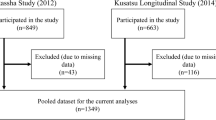Abstract
This study aimed to quantify oxidative metabolism in masseter muscle using near-infrared spectroscopy, in particular for denture wearers. Fourteen normal dentate subjects without malocclusion (ND group, 25–50 years) participated in the quantification of oxidative metabolism. Eleven partially edentulous patients without occlusal stops (PD group, 64–80 years) and ten edentulous patients (CD group, 57–84 years) also participated after prosthodontic treatment. Oxidative metabolism was recorded during gum chewing, maximum clenching and regulated clenching at 5 kgf. The oxygenated hemoglobin at 5 kgf clenching level was normalized to the oxygenated hemoglobin at the lowest blood flow and expressed as oxygen consumption rate (OCR). The relationship of the OCR to the maximum clenching force was analyzed using Pearson’s correlation coefficient, and differences between the PD and CD groups were tested by unpaired Student’s t-test. The OCR showed a significant negative correlation with maximum clenching force in the ND group. The OCR of the PD group was significantly greater than that of the CD group, although the difference in maximum clenching force was not significant between both groups. These results suggest that the aerobic ability of masseter muscle in complete denture wearers is relatively greater than in partial denture wearers with same age level.




Similar content being viewed by others
References
Hamaoka T, McCully KK, Katsumura T, Shimomitsu T, Chance B (2000) Noninvasive measures of muscle metabolism. In: Chandan K, Lester P, Osmo OP (eds) Handbook of oxidants and antioxidants in exercise. Elsevier, Amsterdam, pp 485–509
Hamaoka T, Iwane H, Shimomitsu T, Katsumura T, Murase N, Nishio S, Osada T, Kurosawa Y, Chance B (1996) Noninvasive measures of oxidative metabolism on working human muscles by near-infrared spectroscopy. J Appl Physiol 81:1410–1417
Chance B, Dait MT, Zhang C, Hamoka T, Hagerman F (1992) Recovery from exercise-induced desaturation in the quadriceps muscles of elite competitive rowers. Am J Physiol 262(Cell Physiol 31):C766–C775
Delcanho RE, Kim YJ, Clark GT (1996) Haemodynamic changes induced by submaximal isometric contraction in painful and non-painful human masseter using near-infra-red spectroscopy. Arch Oral Biol 41:585–596
Fujinami Y, Hayakawa I, Hirano S, Watanabe I (2003) Changes in postural control of complete denture wearers after receiving new dentures. Prosthodont Res Prac 2:11–19
Tallgren A, Tryde G (1991) Chewing and swallowing activity of masticatory muscles in patients with a complete upper and a partial lower denture. J Oral Rehabil 18:285–299
Sasaki A (2001) Influence of mastication on the amount of hemoglobin in human brain tissue (in Japanese). J Stomatol Soc 68:72–81
Niwayama M, Lin L, Shao J, Kudo N, Yamamoto K (2000) Quantitative measurement of muscle hemoglobin oxygenation using near-infrared spectroscopy with correction for the influence of a subcutaneous fat layer. Rev Sci Instrum 71:4571–4575
Cui W, Kumar C, Chance B (1991) Experimental study of migration depth for the photons measured at sample surface. Proc Int Soc Opt Eng 1431:180–191
Harris RC, Hultman E, Nordesjo LO (1974) Glycogen, glycolytic intermediates and high-energy phosphates determined in biopsy samples of musculus quadriceps femoris of manta rest. Methods and variance of values. Scand J Clin Lab Invest 33:109–120
Forrester JS (1972) Thermodilution cardiac output determination with a single flow-directed catheter. Am Heart J 83:306
Jöbsis FF (1977) Noninvasive, infrared monitoring of cerebral and myocardial oxygen sufficiency and circulatory parameters. Science 198:1264–1267
De Blasi RA, Cope M, Elwell C, Safoue F, Ferrari M (1993) Noninvasive measurement of human forearm oxygen consumption by near infrared spectroscopy. Eur J Appl Physiol 67:20–25
Ohkubo M, Shimomitsu T, Hamaoka T, Esaki K, Kime R, Fujimaru Y, Ohtsuki T, Sakamoto A, Katsumura T (2000) Measurement of blood volume in musculus trapezius by near infrared spectroscopy (in Japanese). Ther Res 21:1511–1515
Humphreys PW, Lind AR (1963) The blood flow through active and inactive muscles of the forearm during sustained hand-grip contractions. J Physiol 166:120–135
Barcroft H, Millen JLE (1939) The blood flow through muscle during sustained contraction. J Physiol 97:17–31
Bonde-Peterson F, Mork AL, Nielsen E (1975) Local muscle blood flow and sustained contractions of human arm and back muscles. Eur J Appl Physiol 34:43–50
Kimura N, Katsumura T, Hamaoka T, Shimomitsu T (1999) The estimation of oxygen availability in muscle during isometric exercise by near infrared spectroscopy (in Japanese). Nihon Undo Seirigaku Gakkai Zasshi 6:93–102
Schantz P, Fox ER, Norgren P, Tyden A (1981) The relationship between the mean muscle fiber area and the muscle cross-section area of the thigh in subject with large differences in thigh girth. Acta Physiol Scand 133:537–539
Holloszy JO, Booth FW (1976) Biochemical adaptations to endurance exercise in muscle. Annu Rev Physiol 38:273–291
Yamashita S, Sakai S, Hatch JP, Rugh JD (2000) Relationship between oral function and occlusal support in denture wearers. J Oral Rehabil 27:881–886
Garrett NR, Perez P, Elbert C, Kapur KK (1996) Effects of improvements of poorly fitting dentures and new dentures on masseter activity during chewing. J Prosthet Dent 76:394–402
Garrett NR, Perez P, Elbert C, Kapur KK (1996) Effects of improvements of poorly fitting dentures on masticatory performance. J Prosthet Dent 75:269–275
Gunne HJ (1985) The effect of removable partial dentures on mastication and dietary intake. Acta Odontol Scand 43:269–278
Gunne HJ, Wall AK (1985) The effect of new complete dentures on mastication and dietary intake. Acta Odontol Scand 43:257–268
Acknowledgements
This study is part of a research project of the Advanced Medical Service Development in the Japanese Ministry of Education, Culture, Sports, Science and Technology.
Author information
Authors and Affiliations
Corresponding author
Rights and permissions
About this article
Cite this article
Fujii, A., Shinogaya, T., Toda, S. et al. Quantification of oxidative metabolism in masseter muscle of denture wearers. Clin Oral Invest 9, 173–179 (2005). https://doi.org/10.1007/s00784-004-0300-5
Received:
Accepted:
Published:
Issue Date:
DOI: https://doi.org/10.1007/s00784-004-0300-5




